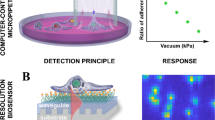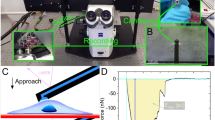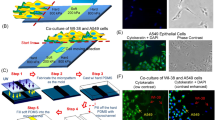Abstract
A METHOD of obtaining large numbers of fixed cells in metaphase arrested by colchicine, from a population of cells growing on a glass surface, by a method dependent on the attenuated adhesion of the cells to the surface has been described1. A modification of this method was suggested to obtain a viable population of synchronous cells. This was demonstrated2 and a method for obtaining large numbers of HeLa cells of which 80 per cent to 95 per cent showed mitotic figures has been described3. The decrease in attachment of the mitotic cells was ascribed to a decrease in the area over which the adhesion occurred1. It is, however, possible that there is a change in the intrinsic strength of the cell-glass adhesions arising from an alteration in the physical properties of the surface of the cells which round up during mitosis. One of the most easily determined of these properties is the ξ-potential arising from the cell surface charge, and accordingly we have made determinations of the electrophoretic mobility of parasynchronous populations of HeLa cells at various stages in the cell cycle.
Similar content being viewed by others
Article PDF
References
Axelrad, A. A., and McCulloch, E. A., Stain Technol., 33, 67 (1958).
Terasima, T., and Tolmach, L. J., Exp. Cell Res., 30, 344 (1963).
Robbins, E., and Marcus, P. I., Science, 144, 1152 (1964).
Engleberg, J., Exp. Cell Res., 23, 218 (1961).
Brent, T. P., Butler, J. A. V., and Crathorn, A. R., Nature, 207, 176 (1965).
Bangham, A. D., Flemens, R., Heard, D., and Seaman, G. V. R., Nature, 182, 642 (1958).
Paul, J., Cell and Tissue Culture, second edition, 207 (E. and S. Livingstone, Edinburgh and London, 1960).
Cook, G. M. W., Heard, D. H., and Seaman, G. V. F., Nature, 188, 1011 (1960).
Mayhew, E. H., and O'Grady, E. A., Nature, 207, 86 (1965).
Ruhenstroth-Bauer, G., and Fuhrmann, G. F., Z. Naturforsch., 16 b, 252 (1961).
Eisenberg, S., Ben-Or, S., and Doljanski, F., Exp. Cell Res., 26, 451 (1962).
Author information
Authors and Affiliations
Rights and permissions
About this article
Cite this article
BRENT, T., FORRESTER, J. Changes in Surface Charge of HeLa Cells during the Cell Cycle. Nature 215, 92–93 (1967). https://doi.org/10.1038/215092a0
Received:
Revised:
Issue date:
DOI: https://doi.org/10.1038/215092a0
This article is cited by
-
Microfluidics for cell separation
Medical & Biological Engineering & Computing (2010)
-
Effect of interferon-α 2b on cells from human embryonic nerve tissue in the early stages of neurogenesis
Neurophysiology (2004)
-
Fractionation of K-562 cells on the basis of their surface properties by partitioning in two-polymer aqueous-phase systems
Cell Biophysics (1987)
-
Changes in surface charge of mouse neuroblastoma cells during growth and morphological differentiation of the cell population
Neurophysiology (1985)
-
Soybean meal processing and quality control
Journal of the American Oil Chemists' Society (1981)



